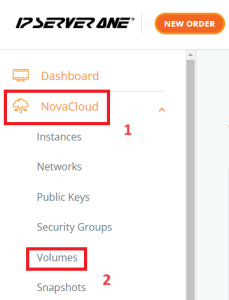Search Our Database
How To Launch Cloud Instance From Snapshot
Introduction
Users can launch new instances directly from snapshots created from existing volumes. A snapshot is a point-in-time, complete copy of a volume and can be used as a backup of a disk image.
Prerequisite
Instructions
Step 1: Log into the customer portal at https://portal.ipserverone.com/
Step 2: Once logged into the portal, navigate to the left panel and click on NovaCloud and dropdown to Volumes as shown in image below.
Step 3: After click on the Volumes from the dropdown menu, kindly ensure your volume exists for snapshot. Snapshots can be created from an unattached volumes and volumes attached to a running instance. You do not need to power off your instance to create a snapshot.
Note: If you do not have any volume in this tab and would like to create a new volume for a snapshot, you may do so by clicking Create Volume to create a blank volume or Create Volume from Image to create a bootable volume.
Step 4: Once you are set on the volume, click on the Snapshots to Create Snapshot. You may create new instances from this snapshot at any time once it is created.
To create a new snapshot, you must name the snapshot and select an existing volume. Hence, Step 3 is necessary to add in existing volume. Once done, proceed clicking Create.
For further details you may refer to the link: How to Create NovaCloud Snapshot in portal
Step 5: To create instance from existing or newly added volume/snapshot, select Instances and click on Launch Instance. Proceed to Create Instance from Volume/Snapshot.
Step 6: Select a Flavor for your Instance.
Note: We offer a variety of Instance types (eg: General Optimized, RAM Optimized, CPU Optimized). You may select the flavor based on your use-case. Flavor can be upgraded in the future when scaling is required. You may refer to this guide to upgrade the plan: How To Resize Cloud Instance.
Step 7: Select Source as Snapshot
Note: The snapshot you own / have created in Step 3 will appear in the dropdown box. Proceed to select snapshot.
Step 8: Name your Instance and click Continue.
Step 9: Generate a new key-pair for your Instance.
Note: You can also Import and use your existing public key. If you do not have any public keys yet, click on Generate to create one.
Step 10: Enter a name for your key-pair. Once done, continue to click Generate.
Note: This key-pair will be used to access your Instance.
Step 11: Download your private key (.pem) for safekeeping.
Note: The private key is unique and non-retrievable nor re-settable, thus, in any case, this key goes missing, you will lose access to your Instance.
Step 12: Continue to select your new key-pair.
Step 13 : (Optional) Apply Predefined Security Group Rules
Step 14 : (Optional) Create a new security group (firewall) rules by clicking Here.
Next, enter a name for the new Security Group. Continue by clicking Create.
Then, select your Security Group. You can also view the Rules of your Security Group.
Note: The default security group allows all egress traffic and block all ingress traffic.
Step 15: Verify the cost of your Instance before you click on Create.
Note: Make sure you have sufficient credit in your account before launching an Instance.
Step 16: Click on View Instances to view your newly launched instance.
Step 17 : Please wait while your Instance is being created. You may refresh this section to view the preparation status.
Result
Your Instance will be in Active status once the launch is successful.
Note: You might want to take note of the IP addresses that have been assigned to your Instance. 
Conclusion
Launching a cloud instance from a snapshot is a quick and reliable way to restore a previous configuration or duplicate an existing environment. This method saves time and ensures consistency across instances.
For additional assistance or if you encounter any issues, please contact our support team at support@ipserverone.com.
Article published on 21 December 2020 by Louis

















